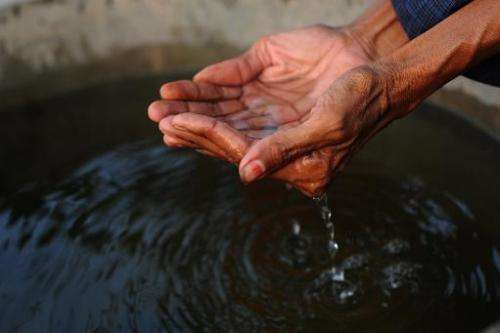Huge strides in global water and sanitation: UN (Update)

Global access to safer drinking water and decent sanitation has hugely improved over the past two decades but the world's poorest often remain sidelined, the UN said Thursday.
Providing better drinking water and sanitation is the bedrock of the battle against diseases such as cholera, diarrhoea, dysentery, hepatitis A, and typhoid.
"It's really an issue of addressing excreta, faeces, poo, I can even say shit. This is the root cause of so many diseases," said Bruce Gordon, coordinator of the water and sanitation arm of the World Health Organization (WHO).
Diarrhoea related to poor water, sanitation and hygiene kills 842,000 people every year, Gordon said.
In a report, the WHO and UNICEF said 89 percent of the globe's population had access to improved water supplies at the end of 2012, up 13 percent on two decades ago.
In UN jargon, an "improved drinking water source" protects the supply from contamination, notably by faeces.
But despite the progress, 748 million people—roughly half of them in Sub-Saharan Africa and most of the rest in Asia—still used unimproved water sources.
The bulk of them lived in rural areas.
The study also examined access to "improved sanitation facilities", which separate excreta from human contact.
By the end of 2012, 64 percent of the global population used such facilities, a rise of 15 percentage points since 1990, it found.
Open-air defecation a scourge
Compounding the lack of access to decent sanitation, a billion people worldwide still defecate in the open air, including 600 million in India, the study found.
Open air defecation—which the report noted is a matter not only of poor sanitation but also of cultural acceptability—can all to easily undermine efforts to improve water supplies.
"It's a matter of demand by the community. They all demand water, but not all of them demand sanitation. What is shocking is the picture of someone practising open defecation and on the other hand, having a mobile phone," said Maria Neira, the WHO's public health chief.
Vastly reducing the number of people without access to improved water and sanitation was one of the Millennium Development Goals, a set of targets set for 2015 by the international community at the turn of the century.
"The MDGs were about poverty alleviation and their job is only half done. And in sanitation, the job is not even half done," said UNICEF expert Rolf Luyendijk.
There has been major progress in narrowing the water and sanitation gap between urban areas—home to over half of the globe's population—and the countryside.
In 1990, only 62 percent of people in rural areas could drink improved water, compared to 95 percent in urban areas. By 2012, the figures had jumped to 82 percent and 96 percent, respectively.
On the sanitation front, the proportion of urban dwellers with access rose by four points over the same period, reaching 80 percent.
In rural areas, the proportion of inhabitants with access to improved sanitation meanwhile jumped from 28 percent to 47 percent.
But that figure masked major disparities.
"Progress on rural sanitation –- where it has occurred –- has primarily benefitted richer people, increasing inequalities," said Neira.
In addition to the disparities between urban and rural areas, there are often also striking differences in access within towns and cities, with the poor far less likely to be covered, the study said.
© 2014 AFP















